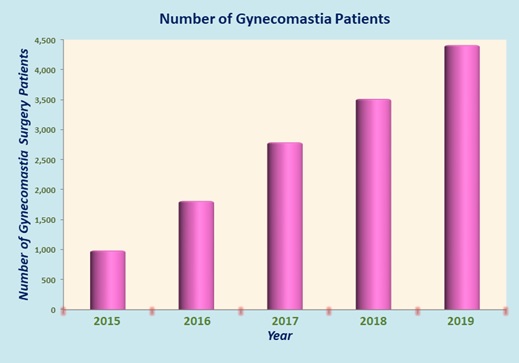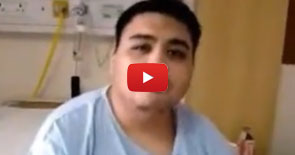What is the Cost of Gynecomastia Surgery at Top Hospitals and Best Surgeons in India?
- The average cost of Gynecomastia Surgeryis very high in western countries.
- India is known worldwide for its advanced medical facilities and promising technology for Gynecomastia Surgery. Many of the best hospitals for Gynecomastia Surgery can be found in India.
- Gynecomastia Surgery Cost in India is much less when compared to any other countries. Also the cost of Gynecomastia Surgery in India is substantially lower than other developed countries of the world.
- On average, the Cost of Gynecomastia Surgery in India can range from approximately Rs. 96,000 ($1,200) to Rs. 1,82,000 ($2,400).
Various deciding factors could determine the price of Gynecomastia in India. These can be broadly classified as Hospital, Medical Team or Patient Dependent factors.
Hospital Factors
- Type of the hospital (Government/Trust/Private).
- Use of insurance, type of insurance or self paid.
- Accreditation of the facility
- Reputation and brand value of the hospital.
Medical Team Factors
- Technology / Approach Used
- Surgery Type
- Type of Anesthesia or Sedation
- Qualification / Expertise of the specialist
- Extent of the surgery needed
Patient Factors
- Patient’s diagnosis
- Patient’s general health
- Room Category selected by the patient
- Other treatment required by the patient in conjunction
The LIST of AVERAGE COST of the Gynecomastia Surgery across TOP 15 cities in India in Indian Rupee (INR) is as follows:
| City | Lowest Cost | Average Cost | Highest Cost |
|---|---|---|---|
| New Delhi | 95,000 | 1,40,000 | 2,65,000 |
| Mumbai | 1,05,000 | 1,55,000 | 2,80,000 |
| Chennai | 1,30,000 | 1,80,000 | 3,05,000 |
| Bangalore | 1,15,000 | 1,65,000 | 2,95,000 |
| Hyderabad | 1,55,000 | 2,05,000 | 3,30,000 |
| Ahmedabad | 1,70,000 | 2,20,000 | 3,45,000 |
| Nagpur | 80,000 | 1,30,000 | 2,55,000 |
| Pune | 1,05,000 | 1,55,000 | 2,80,000 |
| Gurgoan / Gurugram | 95,000 | 1,40,000 | 2,65,000 |
| Kolkata | 1,70,000 | 2,20,000 | 3,45,000 |
| Chandigarh | 1,30,000 | 1,80,000 | 3,05,000 |
| Jaipur | 1,15,000 | 1,65,000 | 2,95,000 |
| Noida | 95,000 | 1,40,000 | 2,65,000 |
| Kerala | 1,70,000 | 2,20,000 | 3,45,000 |
| Goa | 1,55,000 | 2,05,000 | 3,30,000 |
- 1500 INTERNATIONAL PATIENTS OPERATED IN LAST 10 YEARS
- PATIENT SATISFACTION RATIO OF OUR PATIENTS IS 97%
- 2100 Kgs is THE COMBINED WEIGHT LOSS OF OUR PATIENTS THIS YEAR
- 50 INTERNATIONAL PATIENTS HAVE UNDERGONE ANTI- AGEING SURGERIES THIS YEAR
- 6 OF OUR SURGEONS DECORATED WITH HONORS/ AWARDS FOR THEIR EXEMPLARY SERVICES
Contact Us for a FREE No Obligation Quote & Opinion for Gynecomastia in India
Our Hospitals Network and Surgery Group are available in 15 cities of India for our patients to access. Kindly fill up the form for a free opinion from our expert team. We shall get you a Free, No Obligation Opinion from India’s best Surgeons and best Hospitals in India. NO CHARGES LEVIED
Special ALL SERVICES INCLUSIVE Packages available for INTERNATIONAL PATIENTS
Overview:
Gynecomastia for Men in India is a condition which affects a major chunk of the population. It is a condition where the breasts are inflated. While it does not pose a great threat to one’s health, there are difficulties that are caused by having enlarged breasts, not the least which is humiliation and embarrassment. Gynecomastia for Men in India reviews of patients indicates that surgery is among the top three solutions, the others being oral and topical medications.
Gynecomastia Surgery Procedure :
Gynecomastia surgery may be necessary in the form of liposuction, which is a procedure to remove the breast fat. Mastectomy is done by using endoscopy, where tiny incisions are made and involve less time for recovery. The procedure is conducted in a personalized manner, from beginning to the end and this can be customized to suit your preferences.
The results of the surgery can be seen instantly after the procedure. Those who undergo this surgery, do so in the hope that there is no recurrence of the condition. A point to be noted is that one can expect significant levels of pain after the surgery. Patients who have undergone this surgery need to stay in a clean environment after the procedure to avoid any chances of infection.
Benefits of Gynecomastia Surgery for Men :
Some of the benefits of male breasts reductions include:
- Increased self-confidence
- Restored shape and tone of your chest
- Comfort going around without a shirt.
- The chest will appear more masculine after the treatment.
Top 10 Gynecomastia Surgeons in India:
Some of the best Gynecomastia surgeons in India are as follows:
- Dr. Srikanth V.
- Dr. Prateek Arora
- Dr. Avtar Singh Bath
- Dr. Indrapati Singh
- Dr. Milan Doshi
- Dr. Mohan Thomas
- Dr. Charu Sharma
- Dr. Anil Behl
- Dr. Sunil Choudhary
- Dr. Rohit Krishna
- Dr. Rakesh Khazanchi
- Dr. Mukund Jagannathan
- Dr. Antony Aravind
- Dr. Viral Desai
- Dr. Debraj Shome
- Dr. Ajaya Kashyap
- Dr. Vipul Nanda
- Dr. Milind Wagh
- Dr. Rashmi Taneja
- Dr. Devyani Barve
Top 10 Gynecomastia Hospitals In India
This endocrine system disorder in which the ratio of estrogen/androgen is altered is commonly practiced in India with most affordable Gynecomastia Surgery Hospitals in India. Some of the best hospitals are as follows:
- Medanta Hospital, Gurgaon
- Nanavati Max Hospital, Mumbai
- Jaslok Hospital, Mumbai
- Max Hospital, Delhi
- Global Hospital, Parel, Mumbai
- Fortis Hospital Gurgaon
- Manipal Hospital, Bangalore
- Artemis Hospital, Gurgaon
- Kokilaben Hospital, Mumbai
- BLK Max Hospital New Delhi
- Indraprastha Apollo Hospital Delhi
- Primus Super Speciality Hospital Delhi
- Apollo Spectra Hospital, New Delhi
- Gleneagles Global Health City, Chennai
- Aster CMI Hospital, Hebbel, Bangalore
- Fortis Hospital, Mulund
- Apollo Hospitals Chennai
- Fortis Memorial Research Institute Gurgaon
- Breach Candy Hospital Mumbai
- Saifee Hospital, Mumbai
Our Treated Patient Experience – Mr. Samuel Williams from South Africa came to India for his Gynecomastia Surgery.

I had a painless Gynecomastia surgery done by one of the specialist from the group of top cosmetic and obesity surgeons in India. The consultation personnel and other people whom I connected during my first consultation made me walk through the entire process explaining the actual goals and expectations along with the measures for post operative care. Further I was given appointment for evaluation of my medical fitness before actually going for the surgery and to ensure that I was fit for the surgery. During the course I could conveniently place my trust on the doctor from this reputed group. Then one fine day the surgery was performed with caution and precision.
How do I know if I am a good candidate for Gynecomastia for Men Procedure?
One should be in good physical health, be in ideal height to weight proportion and a non smoker. In addition to this, your goals should be realistic. For teenagers, it is best to wait until 18 to 20 years when the puberty has finished and the hormone levels have stabilized. All the potential candidates are required to undertake Free Consultation Gynecomastia for Men in India, which is provided by most of the top notch hospitals in the country.Gynecomastia for Men Procedure & Recovery & Effectiveness :
Gynecomastia surgery may be necessary in the form of liposuction, which is a procedure to remove the breast fat. Mastectomy is done by using endoscopy, where tiny incisions are made and involve less time for recovery. The procedure is conducted in a personalized manner, from beginning to the end and this can be customized to suit your preferences. The results of the surgery can be seen instantly after the procedure. Those who undergo this surgery, do so in the hope that there is no recurrence of the condition. A point to be noted is that one can expect significant levels of pain after the surgery. Patients who have undergone this surgery need to stay in a clean environment after the procedure to avoid any chances of infection.Why Opting Gynecomastia for Men is necessary?
Gynecomastia is an increase in the breast tissue. The condition can occur in both the breasts and may start as a small lump beneath the nipple. The breasts are often known to enlarge unevenly. This condition may be interlinked with other diseases that cannot be ruled out. The treatment to a large extent will be dependent upon the :- Extent of the disease
- The level of tolerance to certain level of medications
- The individual opinion or preference
Why to choose an Indian Hospital for your Gynecomastia for Men?
Indian hospitals have created a niche for themselves in the medical world. A lot has got to do with the state of the art facilities along with the quality of manpower. Low cost Gynecomastia for Men in India is provided by most of the top brands of hospitals where one can undertake the treatment for a fraction of the cost when you compare it to the western hubs.
Affordable Gynecomastia for Men in India is an elective form of surgery, which means that it is not covered by any health insurance company. The cost is comparatively very cost effective, but it also depends on which hospital you get the surgery done and the surgeon who will be undertaking the surgery. The post operative care also costs a lot of money especially when you are on a dose of antibiotics to reduce the pain.
How many patients underwent Gynecomastia Surgery in India in the last 5 years?
- In recent years, India has emerged as a medical hub for patients looking for affordable, accessible and efficient low cost Gynecomastia Surgery.
- An average increase of 15 to 20 percent annually has been observed in the number of patients in the last 5 years.
- The Indian Gynecomastia Surgery hospitals deliver advanced health care and highest quality services backed by elaborate infrastructure and lower treatment cost.
Here are the approximate figures of the patients underwent Gynecomastia in the last 5 years in India –
Are you looking for affordable cost of Gynecomastia Surgery in Top Hospitals of India?
Please consult us to Get free quotes, opinions from Top Hospitals and Best Surgeons of India for Gynecomastia Surgery at Affordable Prices.
Some of the common countries from which patients travel to India for surgery are:
| UAE | United State | United Kingdom |
| Australia | New Zealand | Nigeria |
| Brazil | Canada | Saudi Arabia |
| Bangladesh | Kenya | Iraq |
| Qatar | Yemen | France |
| New Zealand | South Korea | Belgium |
| Nigeria | Germany | Bahrain |
| Singapore | Sudan | China |
| Libya | Spain | Russia |
Before and After
If you are really seeking for Gynecomastia, kindly fill up the form for a free consultation by our surgeons. You will be provided with thorough analysis and suggestions regarding the Gynecomastia you are seeking for.
FAQ’s
Gynecomastia can be defined as the presence of any excess tissue on a male chest and it is often breast tissue mixed with fatty tissue. It frequently occurs in three phases of life. It can occur in a newborn, but frequently disappears. It often occurs during puberty and disappears in many young men, although it may persist forever in some of them. It can also occur later in life due to a variety of factors, which include various diseases (including some cancers), hormonal irregularities, use of bodybuilding (anabolic) steroids, various supplements, marijuana, side effects of various medications, etc. Oftentimes, there are strong hereditary factors as well. Gynecomastia is not related to obesity but may coincide with it. It may be as small as a firm area of tissue just under the nipple or as large as a DD cup pendulous breast.
Sometimes one can feel firm breast tissue directly under the nipple or in the surrounding chest area when the arm is stretched over the head. But this can be misleading – sometimes breast tissue can feel firm and fat feel soft – and other times the fat can feel firm and the breast tissue feel soft. Even a surgeon’s educated hands can be wrong. It is therefore a fool’s errand to try to self diagnose one’s gynecomastia by simply feeling the chest.
If one has excess tissue on the chest, that alone is sufficient alone to diagnose gynecomastia. Regardless of what is felt, the only definitive treatment for the excess tissue will be surgery.
Some guys feel that if their chest is soft, that it is all fat and then they can remove it by diet and exercise. Not true — for an explanation, please see below.
First, diet and exercise are to be strongly recommended – they are great for your general health. But neither will do too much for your gynecomastia. Why?
EXERCISE: Many times, men with gynecomastia has worked out to build up their chest muscles only to be disappointed in their contour. Actually, the excess gynecomastia tissue on the chest sits on top of the muscle and is therefore pushed further out as the muscle enlarges – thereby continuing to mask the muscle contour. It is only after appropriate surgery, when the excess tissues have been removed, that the skin will tighten spontaneously (oftentimes right on the operating table during surgery) and will then shrink down and reveal the nice contours of the underlying chest muscles.
DIET: If a man is overweight, there is predictably an excess of both fat and breast tissue on his chest. Should he lose a significant amount of weight, the fat component will diminish somewhat, but the breast tissue will remain intact. Thus, his breast will become slightly smaller but so will the rest of his body and therefore the disparity of his chest to the rest of his body will remain. In fact, the breast tissue will persist and become even more compacted and prominent, since the intervening fat tissue has been lost.
There is no right or wrong age for surgery to be performed. All too often, teenagers with this problem are given a pat on the shoulder by their pediatrician and told to wait it out until it disappears by itself, often by the “magical” age of 18. Unfortunately, many teenagers spend their entire teenage years waiting in vain for this to occur and are subject to ridicule and embarrassment during this critical time in their lives. On the other hand, one should give adequate time for the condition to resolve by itself.
Pediatricians may also be concerned about the possibility of recurrence of gynecomastia if surgery is performed at too young an age. This has proven not to be the case. Not one of several hundred treated adolescents has ever had a recurrence!
If gynecomastia has been present for two or more years and is stable and has not increased in size, then surgery may be considered. The decision to operate is based not only on the diagnosis of gynecomastia but also on the maturity of the youngster and his capability of understanding the surgery as well as the ability to cope with the post-op pain and to follow the post-op care regimen. Surgery has been successfully performed on hundreds of young men from age 12 through 18. Obviously, this decision is made on an individual basis.
Older men suffering with this condition are also candidates for surgery, but must understand that the skin may not totally tighten after the surgery is performed since they may have lost some elasticity in their skin through the natural process of aging. If deemed necessary by your cosmetic surgeon, various alternative procedures will be discussed at the time of consultation. Again, decisions must be made on an individual basis.
Male breast reduction surgery for established gynecomastia is the only known and recognized treatment. Creams, lotions, massage, injections, exercise and “magic pills” all will do nothing for established gynecomastia. However, they will succeed in making your wallet slimmer.
The presence of gynecomastia does not make you more prone to breast cancer. Several studies have concluded that there is no increased risk of male breast cancer in those men with gynecomastia. It is important to note, however, that one percent of all breast cancers do occur in men. While it is very rarely seen in young men, older men must be made aware of this possibility. Therefore, any new lump, one-sided growth (asymmetry of the breast), skin changes of the breast or nipple, or bloody nipple discharge should be immediately investigated by a physician. A biopsy, a mammogram or a sonogram (ultrasound) examination may be advised.
No. Gynecomastia can affect anyone — it is an “equal opportunity” misery.
True one-sided gynecomastia is rare. Careful consideration must be done to consider other diagnoses, such as a tumor. Once that possibility is removed, then a decision must be made about treatment. Often, one side is much larger than the other — but both sides are frequently affected. In the past, only one side may have been treated — and the patient then returned asking for treatment of the now-larger “normal” side as well.
Therefore, careful examination of both breasts is performed and surgery on both breasts considered if need be. If this smaller amount of gynecomastia is not addressed at surgery, then the end result may be that the operated side will look completely normal and the un-operated side may then be objectionable. It is extremely difficult to operate on the larger side and reduce it just enough to match the other side. Thus, appropriate surgery should be done to optimize both sides at the same time.
Many drugs and medications produce gynecomastia as a side effect. If you are taking any medications, you would be wise to read about any potential gynecomastia-like side effects online. Recently, there has been a flurry of media exposure about the drug Risperdal, a psychotropic medication which produces gynecomastia as a side effect when given to adolescents.
Some illicit drugs such as marijuana, heroin and bodybuilding steroids can also produce gynecomastia. It may also occur while taking seemingly harmless “supplements”, some of which may have hormone–like qualities. In some cases, stopping the medication may result in a diminishment of gynecomastia but most often, once the gynecomastia is present and established, it usually will remain unless corrective male breast reduction surgery is performed.
Some men knowingly take anabolic steroids and attempt to prevent the development of gynecomastia by self medicating themselves with other drugs to block the side effects of the steroids. Most often this is done without a doctor’s supervision. It is our strong professional opinion that tampering with one’s delicately balanced hormonal system – particularly without appropriate physician supervision and blood testing — is totally inappropriate, dangerous to one’s health and should not be done.
Commonly, gynecomastia patients note that it commenced during puberty and then remained with them. In the vast majority of these gynecomastia patients, hormonal tests reveal normal levels of testosterone and estrogen. Cosmetic surgeon will take a complete medical history during the consultation. If there is anything suspicious, then further investigation may be necessary. The patient’s history of the problem may indicate that abnormal hormone levels may be present (eg sudden development of gynecomastia in a healthy 20-something male) and that hormonal evaluation is necessary. The other possible causes such as illicit drugs (marijuana, body-building steroids), side effects of prescribed medications, adrenal tumor, pituitary tumor, testicular tumor, cancer, etc. must also be evaluated.
Successful gynecomastia surgery can be performed despite an underlying medical condition. A thorough evaluation by your personal physician is most important to clear you for elective male breast reduction surgery.
Every effort is made to minimize the scars for surgery. Usually a 3 mm (1/8 inch) incision is made on the side of the chest just down from the armpit. This heals so well that, in time, it will resemble a small blemish rather than a scar.
If an incision is made around the bottom edge of the areola, it tends to heal extremely well and, although permanent, is virtually undetectable in most patients. Please view the photos of peri-areolar scars in the photo gallery elsewhere on this website. Every single photo is that of a post-operative patient with a peri-areolar scar.
Drains are used at the discretion of the surgeon. They are plastic tubes which may be left inside the chest and which exit through the skin. They are usually attached to a rubber bulb which serves to exert a suction effect and then collects any fluids. Drains may remain in place for a brief or an extended period of time. Some surgeons use drains routinely.
Surgery will remove much, but not all of the breast tissue and it will not re-grow (much as a woman’s breast will not re-grow after a mastectomy for breast cancer). Should you gain substantial weight after surgery, then some amount of fat will return to the chest but it will also be distributed over other parts of the body so that you will not regain the specific enlargement on the chest that you had prior to surgery. Conversely, if you lose weight after gynecomastia surgery, the results of the surgery will be enhanced.
This is called a Torsoplasty and it is performed quite often. A torsoplasty can take a good body and make it a great body – but it cannot be performed on obese men. It is designed for men who are at or close to normal weight, but who have stubborn areas of fat that detract from their overall appearance. Since a torsoplasty is a longer operation, with additional anesthesia, the decision to do it must be based upon your surgoeon’s judgment considering your overall health.
In the majority of cases, the chest skin will spontaneously tighten after the excessive tissue beneath (breast and/or fat) has been removed in the course of surgery. Since the nipple/areola is also a skin structure, it too will tighten and diminish in size. In fact, the average areolar shrinkage is about 15-20%. The areola will also darken somewhat in color after surgery. Hard to imagine this? Just think of a balloon with a circle drawn on it. Then let some of the air out — the circle (think of the areola) will be smaller. One added bonus: if an incision has been made in the areola to help remove glandular tissue, the resultant scar will also shrink in size.
In rare cases, when the areola is extremely large, surgery can be performed to reduce it to a more appropriate size. It requires a permanent suture to be placed under the skin to prevent post-operative spreading of the areola. The surgery requires an incision completely around the edge of the areola. Post-op problems can include spreading of the scar, distortion of the areolar contour and the possibility that one could feel the permanent circular suture under the skin.
There are very few absolutely perfectly symmetric human beings. We all have some minor (or major) discrepancies between our right and left sides. During your gynecomastia surgery, your doctor does everything possible to make each side of your chest as good as that side can be. In reducing the excess tissue on the chest, minor asymmetries of the chest, which may have been masked by the excess overlying tissues, are then revealed. For example, one muscle may be larger than the other. The muscle itself may be attached to the ribs and sternum in slightly different ways on both sides. The rib cage may be different on each side. Posture and scoliosis (curvature of the spine) will also play a role.
Some men start off with asymmetric gynecomastia – one breast being larger than the other. Although surgery will reduce each side to be as good as possible, the (originally) larger side, with more stretched out skin and perhaps a larger diameter areola, will take longer to tighten and catch up to the smaller side – and it may never catch up 100%.
For the most part, there will be an overall significant improvement of the chest. Some men may have been mildly asymmetric to begin with – but they never noticed it. After surgery, and after carefully inspecting their chest 100 times a day, men may notice and dwell on certain minor asymmetries. Unfortunately, some of these post-op minor asymmetries cannot be corrected.
One should NOT massage the chest unless instructed by your doctor. Massage can actually cause more swelling. There may come a time in your healing phase, usually at least a month or two after surgery, when indeed massage may be beneficial. Your doctor will tell you when and how to massage if he feels it would be helpful.
Doctor recommends at least four weeks away from strenuous exercise. Why? Isn’t exercise good for you? Yes, exercise is great — but when one exercises, the blood pressure always rises. And it is the rise in blood pressure, soon after surgery that can result in increased swelling. It might also open a blood vessel under the skin that had been sealed during surgery – and you might bleed and fill up with blood under the skin. This can happen even weeks after surgery. With anticipated normal healing, one may gradually return to the gym after one month. There may be some swelling upon return from the gym – then overnight use of the compression garment would be helpful.
5 years after surgery with weight loss and exercise. The results of the surgery will get even better.
Acne on the chest area will not affect your eligibility for gynecomastia surgery, as long as it is quiet. If there is active pustules or infection, these must be treated by a dermatologist until they are quiet. If surgery is performed with any active infection in the area, then it substantially increases the risk for an infection after surgery.
What is skin elasticity and why is it so important in consideration for gynecomastia surgery? Ø Think of skin elasticity as billions of tiny “rubber bands” in the skin. If the “rubber bands” are stretched too far and for too long, they become tired and lose their ability to bounce back and tighten by themselves. The skin sign of extreme loss of elasticity is stretch marks, which are areas of the skin where the elastic fibers have actually broken, just like stretching a rubber band until it breaks. There is no way to restore elasticity once it has been lost.
It is important to have sufficient skin elasticity in order to qualify for minimal scar surgery. In essence, the excess tissues are removed via the minimal incisions – but the skin has to be able to tighten by itself. This tightening ability is determined by the amount of elasticity in your skin.
Elasticity is diminished in several ways: by the natural aging process, by smoking, by excess sun exposure and tanning, and most importantly, by being overweight or obese and thereby stretching out the skin. Once elasticity is lost for any or all of the above reasons, there is no way to replace it. Thus, in certain cases, there may be a need for additional incisions during surgery to tighten up any loose skin
There can be very thin patients with large breasts and overweight men with flat chests. However, overweight men often put extra fat on their chest, for that is one of the places that fat is first deposited. Frequently, obesity and gynecomastia will coincide.
Losing just a few pounds or even 10 pounds will not affect your surgery one way or the other. An unhealthy crash diet is certainly not recommended. Rather, a good, healthy diet with lots of protein is worthwhile. Sometimes, supplements with extra Vitamin C and Zinc may be helpful.
However, if you plan on losing substantial amounts of weight, then surgery should definitely be deferred until the weight is lost and you are stable at the new weight. Then a re-evaluation may be necessary in order to assess the specific type of surgery required for your new shape.
Absolutely yes. However, many vegetarians are low in protein, which is necessary for proper healing after surgery. Therefore, it is recommended that you increase your protein intake prior to and subsequent to surgery. This can be in the form of extra protein shakes. You might consider some lean poultry or fish as well.
No, this is not necessary. If you wish to work out, that is fine, but it will have no effect on the operation.
Aside from its deleterious effects on the lungs, smoking contains nicotine. Nicotine acts on small blood vessels to tighten them, thereby narrowing them and reducing blood flow. Obviously, good blood flow is essential to proper wound healing. It is our firm recommendation that smoking be stopped for two weeks prior to surgery and two weeks subsequent to surgery.
A certain amount of breast tissue is present in 100% of men – that is the normal condition. Gynecomastia is an excess of tissue, including breast tissue. Proper surgical treatment is aimed at reducing the excess tissue to a more normal amount.
Gynecomastia surgery is not cancer surgery, where every last cell of breast tissue need be removed. In fact, if surgery for gynecomastia were aimed at removing all breast tissue, the results would be near mutilation of the chest.
The outcome of the gynecomastia surgery may be too variable. Aside from the surgery itself, there is a question of appropriate patient compliance with post-operative instructions, the vagaries of individual healing characteristics, and of course, the influences of Mother Nature. The cosmetic surgeon can make is that he will use all of his energy, experience, diligence and skills to provide the very best operation possible for every patients.








